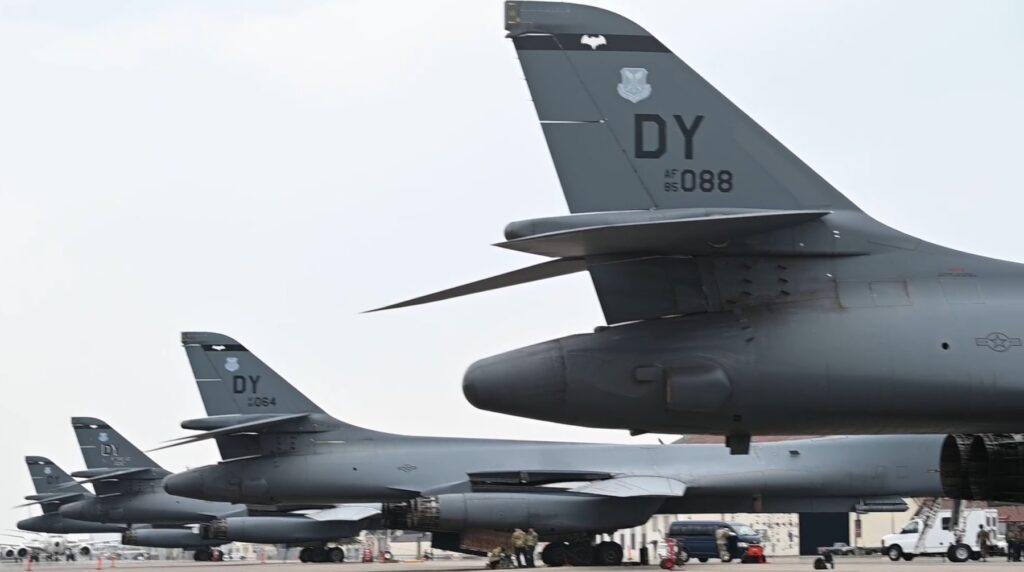The United States has stationed a group of four supersonic B-1B bombers in northern Japan, which is located close to Russia’s Far East, to “discourage aggression.”
The deployment, known as the Bomber Task Force mission, enables the U.S. bomber fleet to maintain proficiency, enhance readiness, and strengthen integration with other American or coalition forces, the U.S. Eighth Air Force said in response to a Newsweek email inquiry.
Newsweek has also reached out to the Russian Defense Ministry for comment by email.
Why It Matters
Japan, a key American treaty ally in Northeast Asia, is part of the First Island Chain under a U.S. maritime containment strategy, seeking to restrict Russia’s military access to the Pacific Ocean. The U.S. military has deployed multiple air, ground and naval units across Japan.
The U.S. bomber force, consisting of the B-1B Lancer, B-2 Spirit, and B-52H Stratofortress, has been conducting Bomber Task Force missions through rotational deployments at American and allied air bases in the Pacific theater since 2018, strengthening deterrence in the region.
The Russian military operates near Japan frequently, where the two countries are separated by the sea. From April 2024 to March 2025, the Japanese fighter jets were scrambled a total of 237 times against Russian aircraft that were approaching the nation’s sovereign airspace.
What To Know
In a video released by the U.S. Pacific Air Forces on Wednesday, four B-1B bombers were seen parking at Misawa Air Base in Japan for the Bomber Task Force 25-2 mission on April 18.
The first pair of B-1B bombers arrived at the air base, which is located in the northern part of the Japanese main island of Honshu, on April 15 from their home station at Dyess Air Force Base in Texas. This marked the first rotational Bomber Task Force mission in Japan.
Three days later, the second pair of B-1B bombers assigned to Dyess Air Force Base were tracked flying off the Kamchatka Peninsula in the Russian Far East and heading toward Misawa Air Base. The U.S. Pacific Air Forces confirmed their deployment in Japan on Wednesday.
“The ability to operate from multiple locations gives our bomber forces a level of flexibility and allows commanders’ to remain unpredictable,” the U.S. Eighth Air Force said, adding that each Bomber Task Force mission’s length and the number of bombers can be changed.
On Thursday, one of the deployed B-1B bombers participated in a large-scale training near the Japanese island of Okinawa with American and Japanese military aircraft, which aimed at strengthening their deterrence and response capabilities, the U.S. Pacific Air Forces said.
The B-1B bomber can carry up to 75,000 pounds of bombs and missiles, which is the largest payload of conventional weapons in the U.S. Air Force inventory. It has a maximum speed of Mach 1.2, traveling faster than the speed of sound, with an intercontinental flight range.
What People Are Saying
The U.S. Eighth Air Force said: “We can rapidly deploy and operate from traditional and non-traditional operating locations with varying levels of capacity and support. Any base our bombers do operate out of, allows us to test concepts and develop our tactics, techniques, and procedures to move faster, smarter, and more effectively.”
The U.S. Pacific Air Forces said: “Bomber Task Force deployments familiarize aircrew with air bases and operations in different Geographic Combatant Commands’ areas of operations. This deployment to Japan showcases the United States’ commitment to the Indo-Pacific region and our Allies and partners.”
What Happens Next
It remains to be seen where the Japan-based B-1B bombers will conduct further training and exercises during this Bomber Task Force mission. Meanwhile, up to six B-2 bombers are deployed at Diego Garcia, an Indian Ocean island, amid rising tensions in the Middle East.
Read the full article here
